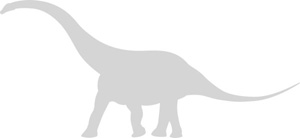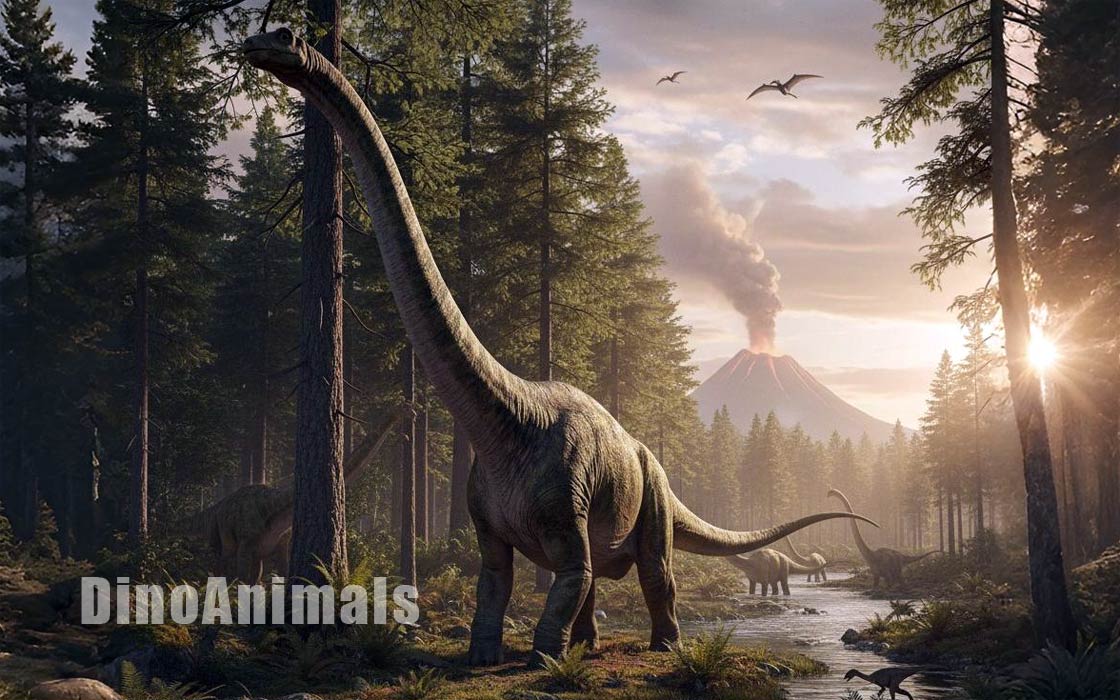Every month, 100,000 readers use the Dinosaur Database, but we receive no support from you. Developing and updating the database requires a lot of work. If you want it to remain open and be updated, please support us via the "Buy us a coffee" button available on every page or via the Support page.
Dinosaur: Diplodocus longus

| Length*: | 31 m | 101.7 ft |
| Weight*: | 24 t | 52,911 lb |
| Speed: | 22 km/h | 14 mph |
*The largest known specimen
Period
Epoch: Late Jurassic
Stage: Late Kimmeridgian-Early Tithonian
Years: 154.8–145 Ma
Details
Status: nomen dubium
Author: Marsh
Year: 1878
Distribution
Area: North America
Country: USA
Region: Colorado
Formation: Morrison
Description
Diplodocus longus
Diplodocus longus is one of the most recognizable dinosaurs, known for its extraordinarily long neck and tail. This giant herbivore lived approximately 155 to 145 million years ago during the Late Jurassic period. The name “Diplodocus” means “double beam,” referring to the unique double row of bones located under its tail vertebrae, which likely provided additional support and flexibility. Fossils of Diplodocus have been primarily found in the Morrison Formation of North America, particularly in the western United States, such as Colorado, Montana, Utah, and Wyoming.
Physical Characteristics
Diplodocus longus was one of the longest dinosaurs, reaching up to 24 to 27 meters (79 to 88 feet) in length, with some estimates suggesting even longer individuals (31 meters). Its neck alone could measure up to 6 to 8 meters (20 to 26 feet), while its whip-like tail could be even longer. Despite its impressive length, Diplodocus was relatively lightweight for its size, with estimates suggesting a mass of around 10 to 15 metric tons, with some estimates suggesting even heavier individuals (24 tons). It had a small head with peg-like teeth positioned at the front of its jaws, well-suited for stripping leaves from branches. The limbs of Diplodocus were relatively short compared to other sauropods, giving it a low-slung, almost horizontal posture, and its forelimbs were shorter than its hind limbs, which contributed to its distinctive shape.
Diet and Feeding Habits
As a herbivore, Diplodocus longus fed primarily on low-lying vegetation, such as ferns, cycads, and other Jurassic plants. Its long neck allowed it to reach food over a wide area without needing to move its massive body frequently, conserving energy. Unlike some other sauropods, the teeth of Diplodocus were not adapted for chewing but were designed to strip leaves and small branches from plants. It is believed that Diplodocus may have swallowed stones, known as gastroliths, to help grind and digest the tough plant material in its stomach, much like modern birds do today.
Habitat and Distribution
Diplodocus longus lived in the semi-arid floodplains and river valleys of what is now the western United States. The Morrison Formation, where most Diplodocus fossils have been found, was a diverse ecosystem with a mix of forests, fern prairies, and wetlands. These environments would have supported a wide variety of plant life, providing ample food for large herbivores like Diplodocus. The Morrison Formation is renowned for its rich dinosaur fauna, including other sauropods, theropods, and ornithischians, making it a key site for understanding Late Jurassic ecosystems.
Behavior and Social Structure
Like many other sauropods, Diplodocus likely lived in herds, which would have provided protection against predators such as Allosaurus and Ceratosaurus. Living in groups would also have helped with social interaction and mating. Fossil trackways suggest that sauropods, including Diplodocus, traveled in groups that may have included individuals of different ages, with younger dinosaurs potentially staying in the center of the herd for protection. The long tail of Diplodocus could have been used for communication, display, or defense. Some paleontologists speculate that the tail may have functioned like a whip, generating loud noises to ward off predators or competitors.
Discovery and Research
Diplodocus longus was first discovered in 1877 by fossil hunter Samuel Wendell Williston in the Morrison Formation of Colorado. The species was described and named by paleontologist Othniel Charles Marsh in 1878. Since then, numerous Diplodocus skeletons have been found, making it one of the best-represented sauropods in the fossil record.
Significance and Interesting Facts
Diplodocus longus is significant for its incredible length and its unique adaptations among sauropods. It provides key insights into the diversity and evolution of sauropod dinosaurs during the Late Jurassic. The long, whip-like tail of Diplodocus remains a subject of research and fascination, with recent studies suggesting that it could have been capable of producing sonic booms, which would have been used as a defense mechanism or in social interactions. The extensive fossil record of Diplodocus has allowed paleontologists to study its growth, biomechanics, and behavior in detail, making it one of the most thoroughly understood sauropods. Its elongated body shape and specialized feeding strategy exemplify the diversity of dinosaur adaptations to their environments.
Locations
Sources
Material: Caudal vertebrae, other material ?
References: Tschopp, E., Mateus, O. & Benson, R.B.J. (2015) "A specimen-level phylogenetic analysis and taxonomic revision of Diplodocidae (Dinosauria, Sauropoda).
Hatcher, J. B. (1901). Diplodocus (Marsh): Its osteology, taxonomy, and probable habits, with a restoration of the skeleton. Memoirs of the Carnegie Museum, 1(1), 1-63.
Upchurch, P., Barrett, P. M., & Dodson, P. (2004). Sauropoda. In Weishampel, D. B., Dodson, P., & Osmólska, H. (Eds.), The Dinosauria (Second Edition). University of California Press.




